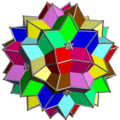| Compounds of ten octahedra | |
|---|---|
  | |
| Type | Uniform compound |
| Index | UC15 and UC16 |
| Polyhedra | 10 octahedra |
| Faces | 20+60 triangles |
| Edges | 120 |
| Vertices | 60 |
| Symmetry group | icosahedral (Ih) |
| Subgroup restricting to one constituent | 3-fold antiprismatic (D3d) |

The compounds of ten octahedra UC15 and UC16 are two uniform polyhedron compounds. They are composed of a symmetric arrangement of 10 octahedra, considered as triangular antiprisms, aligned with the axes of three-fold rotational symmetry of an icosahedron. The two compounds differ in the orientation of their octahedra: each compound may be transformed into the other by rotating each octahedron by 60 degrees.
Contents
For UC15, the convex hull of this compound is a nonuniform rhombicosidodecahedron. For UC16, the convex hull would be a nonuniform truncated icosahedron.
